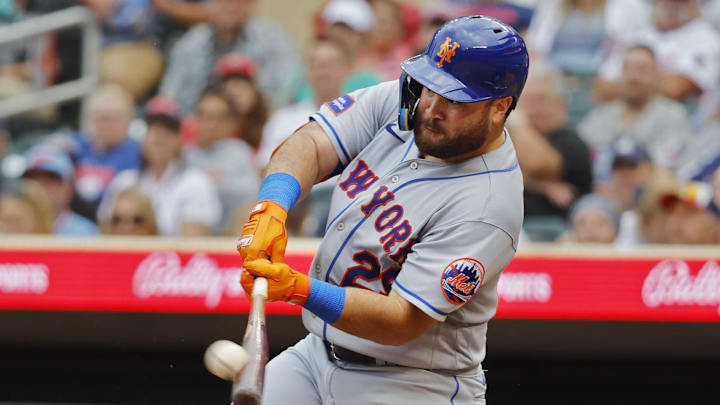August was a fun month of New York Mets baseball if your name is DJ Stewart. He became a fan favorite quickly by simply doing the things we had hoped Daniel Vogelbach and Darin Ruf would. He hit for power. He played defense sometimes better than expected. Stewart was the ultimate underdog.
DJ stopped spinning the hits in September. He was much less powerful and a weak conclusion should have us asking exactly where he fits into the picture next year. It seemed like a foregone conclusion he’d be a backup outfielder. Now, as one of his biggest fans, I’m not so sure.
The Mets need to make DJ Stewart earn a roster spot
A left handed corner outfielder with pop has a place on most team's benches. This is the most flattering way to describe Stewart whose career has been spent mostly as a Four-A player. The excitement of the Mets maybe finally grabbing a guy off the scrap heap and seeing him succeed was short lived. Stewart has a place on the Mets next year, it's just not on the Opening Day roster unless he wins his way there and even then it may take an injury.
Jeff McNeil and his ability to play the outfield gives this team the luxury of not needing more than one outfielder on the bench at a given time. It allowed them to get by with Vogelbach on the roster in 2023—ugh. It may be one of the reasons why Stewart isn't so necessary.
The Mets bench is wide open for next year. Does Luis Guillorme return as the "play everywhere" infielder or has his lack of minor league options turned him into a non-tender candidate? How many of Brett Baty, Ronny Mauricio, and Mark Vientos are on the roster, too? Sitting them regularly seems like a stunt in their development.
Stewart outperformed each of those players, but it’s his age that has caught up and snipped some of the patience. The Mets can slowly give playing time to others. With Stewart, time is limited.
Because he does have a minor league option remaining, the Mets should plan for him to not be with the team when they open the 2024 season. Use him as insurance for the outfield and not someone to be relied upon.
Stewart’s big weakness was an inability to hit left-handed pitchers. In 49 plate appearances he batted only .154/.313/.282 with a strikeout in one-third of his 39 at-bats. The limitation is obvious. Luckily for him, most pitchers throw right-handed. Hammering 10 home runs in 136 trips to the plate with a .265/.333/.562 slash line is too solid for the Mets to pass up even if many of the strikeouts followed him there, too.
